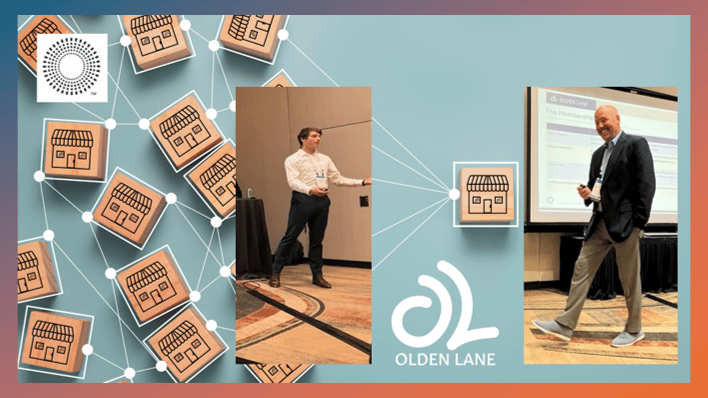- Olden Lane Newsletter
- Posts
- From Bezos to Bonds: Navigating Innovation and Uncertainty
From Bezos to Bonds: Navigating Innovation and Uncertainty
Olden Lane June 2025 Newsletter, Edition 23
What Can We Learn from Jeff Bezos?
I recently had the occasion to read the collection of Jeff Bezos’ Shareholder Letters from his time at the helm of Amazon. While the full magnitude of Bezos’ contributions to the world of business are still being fully understood, there is no denying that much can be learned from a review of this compilation. And, the importance of collecting, maintaining and reviewing works such as these was captured by President Franklin Roosevelt when he elegantly described the importance of anthologies more generally:
"It seems to me that the dedication of a library is an act of faith. To bring together the resources of the past and to house them in buildings where they will be preserved for the use of men and women in the future, a nation must believe in three things. It must believe in the past. It must believe in the future. It must, above all, believe in the capacity of its own people so to learn from the past that they can gain in judgment in creating their own future.”
Below, I distill Bezos’ shareholder letters from 1997 to 2021 into seven core lessons, each drawn from recurring themes and direct insights across the years. With the hope that we can glean something from the past to build a better future, I then make an analogy to the credit union industry or to our business at Olden Lane, as appropriate.
1. Maintain a Long-Term Mindset
In 1997, Bezos’ inaugural letter set the tone for Amazon’s strategy: prioritize long-term market leadership over short-term profits. He emphasized that decisions would be made with a view to maximizing long-term free cash flow, not just quarterly earnings. This approach enabled bold investments in infrastructure, technology, and customer experience, often at the expense of immediate financial results. Throughout later letters (e.g., 2004, 2014), Bezos reiterates this philosophy as a competitive advantage, allowing Amazon to build enduring value and to innovate without being beholden to Wall Street pressures.
This is a lesson which should give hope to credit unions large and small. As cooperatives with a base of loyal customers and decades of amassed capital, credit unions are well-equipped to adopt the long-term mindset. Fortunately, the quarter-to-quarter pressure to meet analyst expectations is just not a reality in our industry. At the same time, however, credit unions must resist the temptation to grow complacent. The pace of change is quicker than at any time in memory and nimble decision making is at a premium.
Referenced in: 1997, 2004, 2014
2. Obsess Over Customers, Not Competitors
“Customer obsession” is the most consistent theme across all of Bezos’ writings. He often describes it as Amazon’s first core principle. Rather than reacting to competitors, Amazon stays focused on innovating for customers, reducing friction, and driving down prices. In his 2016 letter, Bezos explains how listening to customers, even when they are silent, leads to invention. For Amazon, this approach was at the root of breakthroughs like Prime, Kindle, and AWS.
Bezos asserts that “[t]here are many ways to center a business,” offering such alternative organizational lodestars as competitor focused, product focused, technology focused or business model focused. In the end, however, he favors a customer obsession:
“There are many advantages to a customer-centric approach, but here’s the big one: customers are always beautifully, wonderfully dissatisfied, even when they report being happy and business is great. Even when they don’t yet know it, customers want something better, and your desire to delight customers will drive you to invent on their behalf. No customer ever asked Amazon to create the Prime membership program, but it sure turns out they wanted it, and I could give you many such examples.”
Here again, credit unions should enjoy a real advantage. With an industry built on “people helping people,” client obsession should already be an integral part of our work.
In our experience, the most successful companies engage in their mission with an exuberant enjoyment of life – a joie de vivre. Again, Bezos’ instruction in how to take that mission to another level is instructive:
“…experiment patiently, accept failures, plant seeds, protect saplings, and double down when you see customer delight. A customer-obsessed culture best creates the conditions where all of that can happen.”
Referenced in: 1997, 2016, 2018
3. Embrace External Trends Early
Bezos urges leaders to "lean into the future." In the 2010 and 2016 letters, he discusses how technological megatrend (i.e. cloud computing, machine learning, and mobile) must be embraced quickly. Companies that resist change risk irrelevance. Amazon’s rapid adoption of these trends gave it a major edge, especially with AWS. Bezos also emphasizes the cost of being late is greater than the cost of being wrong early.
Against today’s backdrop, this might be the most important of Bezos’ lessons. The sweeping introduction of AI and its panoply of new tools makes this one of the most exciting times in the history of business. While many are cowering in fear, lamenting the anticipated reshuffling of jobs, others are leaning into the task of imagining all that AI enables for their business. At Olden Lane, we are laser focused on improving our process. We need to do more and to do better for our credit union clients. The countless possibilities make it very easy to wake up and get to work every morning before the alarm bell rings!
Referenced in: 2010, 2016, 2018
4. Move Fast and Make Reversible Decisions
In the 2015 and 2016 letters, Bezos emphasizes the importance of high quality and high velocity decisions. Many companies treat all decisions as high stakes, slowing innovation. Bezos argues persuasively that most decisions should be made quickly with about 70% of the information you wish you had. This bias toward action helps Amazon maintain agility as it scales: “[s]peed matters in business – plus a high-velocity decision making environment is more fun too.”
Many business commentators have spoken of the value of “failing fast.” Bezos espouses a similar philosophy, where agility is the key. He suggests that leaders should not “deliberate over easily reversible decisions.”
As a corollary, Bezos also introduces the concept of “disagree and commit,” a process whereby an objector acquiesces despite a genuine disagreement of opinion and without needing to be convinced. After describing such an episode at Amazon, Bezos offers “[c]onsider how much slower this decision cycle would have been if the team had actually had to convince me rather than simply get my commitment.”
In working with credit unions large and small, too often we observe analysis by paralysis. While we certainly appreciate the need for deliberate decision making in certain instances, we are confident that, as a general matter, credit unions would benefit from embracing a more active framework emphasizing high quality and high velocity judgments.
Referenced in: 2015, 2016
5. Wander and Experiment
Bezos places a premium on exploring new ideas without a clear path. He views this “wandering” process as essential to innovation and long-term growth and observes that the outsized discoveries in life and in business are often the product of “non-linear” thinking.
Of course, the best results are closely related to the people that an organization can attract to its ranks. Here, Amazon has always favored a “culture of builders,” comprised of people who “see the way we do things as just the way we do things now.”
In the credit union space, much of the wandering occurs on the CUSO side of the business, where we regularly observe experimentation that has led to impressive breakthroughs in client service, product development, account opening or payments. This is a real bright spot. And we would love to see regulators embrace additional latitude in the size and shape of these investments. At the same time, we are confident that more can be done to encourage experimentation within the core business. While we respect certain non-negotiables around privacy, client data and cybersecurity, team members in other facets of the business should be encouraged to wander more often.
In my first role as a manager, I learned quickly that it is easier to pull on the reigns than to push a horse out of the barn. At Olden Lane, we credit an active process of experimentation and wandering for allowing us to identify the palpable industry need that eventually led to our top spot on the credit union sub debt league table. In the same vein, our wandering with clients allowed us to uncover and embrace the credit union M&A revolution that is still in its earliest days (Day 1?).
Referenced in: 2002, 2015, 2016
6. Stay a “Day 1” Company
The “Day 1” mindset is a major theme from the 1997 Amazon letter that is revisited in 2016. A “Day 1” mentality is about staying nimble, experimental, and hungry, regardless of scale. Bezos fears “Day 2,” as he warns that it is stasis followed by irrelevance. Fighting bureaucracy, focusing on results, and being willing to experiment are the keys to keeping “Day 2” at bay. The 2016 letter outlines the proper mix to stay Day 1: customer obsession, embracing trends, and making fast decisions.
For my money, a Day 1 mentality equates to a palpable hunger to do more, to do better and to do it all more efficiently. For Dos Equis’ most interesting man in the world, Day 1 is captured in the mantra to “stay thirsty my friends.” Or, as another business icon, Steve Jobs, might have put it: “Stay hungry. Stay foolish.”
Referenced in: 1997, 2016
7. Earn Trust Through Operational Excellence
In his final two letters (2020 and 2021), Bezos stresses that trust is built through delivering reliably for clients. For Bezos “operational excellence” is table stakes. This includes meeting high bar customer expectations and improving the experience and compensation for employees. As Amazon faced increased scrutiny, Bezos highlighted how companies must be “Earth’s Best Employer” and “Earth’s Safest Place to Work,” tying corporate success to social responsibility.
This is another area where credit unions should have a natural advantage, as the credit union principles emphasize member ownership, democratic control and mutual self-help.
Referenced in: 2020, 2021
Conclusion
All in all, Bezos’ letters offer a window into the thinking of one of the world’s most successful business icons. More importantly, his ideas are current, tangible and accessible. It is well worth the time to sit with his letters and spill his ideas across your own business.
June 2025 Market Commentary
Written by Larry Rascio
This last Friday one of our clients called to ask me: “why are 10Y Treasury yields trading above 4.51% today?” I had to answer that question with a question, “can tell me why they were trading at 4.31% (20bp lower) two days ago?” Their answer was, of course, no. The real answer is: moves are dictated by whatever flows come out of the largest fixed-income portfolio managers and the pain-points of others that may or may not get triggered. There is no shortage of analysts out there making market predictions by parsing every word uttered by a Fed official or using what they learned getting their economics degrees to explain moves. That may have worked a while back but as our loyal readers know, we at Olden Lane tend to look at things much differently. Focusing more on analyzing market behaviors leading up to and after “events”, knowing what the larger players know (or think they know) and how they are positioned tells us more about the future path of rates than any economist.
Interest rate and currency markets have oscillated in wide ranges over the past two years. Since mid-2023, 10-year US Treasury yields have traversed nearly the entire range from 3.5% to 5.0% five times before settling near the middle of that range which is where they are at the time of writing. When US Treasury yields rose from the lower end of the range, the US dollar appreciated. And when they fell from the upper end, the US dollar depreciated, which makes sense. Back in January we wrote that the US dollar and Treasury yields would break these ranges to the downside – leaving the currency materially weaker and yields materially lower in 2025.
At one point in early April, both calls looked on track. 10-year Treasury yields nosedived from near 5% to below 4% and the DXY index fell 10% – both from their mid-January highs. However since “Liberation Day”, the USD has decoupled from 10-year yields. Instead of appreciating in line with Treasury yields, the US dollar has depreciated, breaking below its two-year range. While this decoupling may not last, we do think that the USD will continue to depreciate in the near term.
What about Treasury yields? As we’ve been saying for the past few months now, we’re looking for economic conditions/data to deteriorate. The question is will that deterioration be bond bullish (lower ylds) or bearish (higher ylds? The latest spat of data which includes the Fed’s beige book and ISM show weakness but doesn’t help with the bull/bear argument. The Beige Book showed only 3 of 12 regions growing and 6 declining. The April ISM price index registered the largest 2 month increase since February/March ’21. But what really caught our eyes was a plunge in new orders and the backlog of orders. Despite these backlogs, prices rose 96 consecutive months and just accelerated. Taken together this wreaks of stagflation (bond bearish). That said, the rates market hasn’t traded on fundamental information in quite a long time. As a result, we’re still looking for 10-year yields to trade below the April intra-day lows of 3.87% sometime over the next 9 months but struggle to breach the 4.87% level in a sell-off over that same period. And while good things proverbially come to those who wait, 9 months may seem like an eternity to investors – most of whom lack the patience to stay around that long. Fortunately for Treasury traders, there is another mechanism waiting to launch itself into a larger trend; the shape of the yield curve.
The US Treasury curve should continue to steepen but might not be led by the back-end which has been the case this year. Instead, we expect investors to face lower yields across the Treasury curve, led by shorter maturities otherwise known as “bull steepening.” Still, just as lower yields have proved elusive over the past two years, stubbornly high levels may continue to frustrate investors over the next six months. While we have been in the camp that tariffs are ultimately deflationary there are enough economists and traders who believe just the opposite. This “disagreement” should be enough to prevent the Fed from taking any action this year, a dynamic which should keep US Treasury yields well within their 12 month range.
As investors embrace a reflationary outlook toward the end of an easing cycle, they are likely to shy away from Treasuries with longer maturities, especially as their yields decline in sympathy with lower overnight rates. In addition, running in the background, the Fed’s presence in the Treasury market should continue to decline. At present, the Fed holds more duration risk in longer maturities than the private sector. As the Fed gradually exits the marketplace, we expect the private sector to assume more duration risk. And to do so, we think investors will demand more compensation in the form of yield.
In the end, we expect uncertainty to remain a constant in the lives of investors through our forecast horizon. But a much steeper US Treasury curve should help to compensate them for the inconvenience.
Are the Bond Vigilantes Back?
“Vigilantes” tend to trap policy makers in a vicious cycle of wanting to lower interest rates to stimulate growth at the risk of crippling inflation. Look no further than Japan and their “failed” 30Y bond auction. There is an entire generation of traders (and algos) that literally do not know how to function in a world where the BOJ isn’t buying 50% of the issued debt. Some may figure out how to navigate this paradigm but panic and over/under reaction biases are what create trading opportunities.
What does the BOJ do now? Does it immediately start cutting rates and reinstitute yield curve control to save the long-end of its bond market risking inflation and potential currency collapse? Does it do nothing and watch yields rip higher potentially triggering a cascade of local bank failures? With Japanese government bond yields already at multi-decade highs, JGB traders probably expected their 20Y auction to go just fine. What they got was nothing short of catastrophic. A tail surge of 1.14 vs 0.34 last month. In plain terms a “tail” is the difference between the yield the market expects bidders to pay for the bonds at auction versus what they actually pay. Japan just experienced the largest ‘tail’ since 1987, clear evidence that demand for Japanese bonds as suddenly evaporated.
Bottom Line:
· Rates will continue to be range bound
· Moves will appear to be random
· Pay attention to flows and market behaviors
· Widen your stop-loss bands
A big note of thanks to America’s Credit Unions for hosting Eli Krahn, Mike Macchiarola and Dan Prezioso at this year’s Finance Council in Phoenix.
Our presentation on Branch Sales: An Emerging Strategy for Balance Sheet Management and Market Rationalization – assisted by Chelsea Zastrow of Connexus Credit Union and Kienan Shaw of ACU – seems to have been well received.

Olden Lane to Attend the ENGAGE Conference in Orlando
Dan Prezioso and Paul Kellam will be attending the ENGAGE Conference and looking forward to spending some time with our credit union friends from the Southeastern part of the country.

